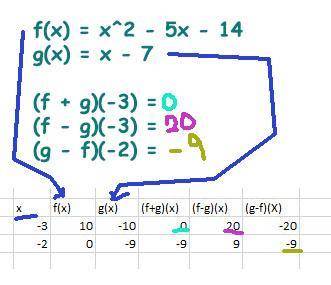 1
1 1.  is not the same as
is not the same as  , because the first statement is equal to
, because the first statement is equal to  and the second statement is equal to
and the second statement is equal to  .
.
The first question is false.
2. The second statement is true, because when we multiply equal signs the result is always positive. In this case, both signs have the same nature, negative and negative, so the result is positive.
3. The expression is 
First, we solve powers and divisons:  (notice that the negative sign is outside the square power.
(notice that the negative sign is outside the square power.
Then, we sum: 
Therefore, the right answer is -52.
4. The equation is 
Solving for 

So, the answer is 13.
5. The expression is 
So,

6. The function is  , if
, if  , then
, then  .
.
Therefore, the statement is true.
7. False, beacuse the domain refers to the input values and y-values refers to output values. So, they don't means the same thing.
8. This statement is true, because to function be a function, first it has to be a relation, because a function must relate two sets to be one.
 1
1 1.  is not the same as
is not the same as  , because the first statement is equal to
, because the first statement is equal to  and the second statement is equal to
and the second statement is equal to  .
.
The first question is false.
2. The second statement is true, because when we multiply equal signs the result is always positive. In this case, both signs have the same nature, negative and negative, so the result is positive.
3. The expression is 
First, we solve powers and divisons:  (notice that the negative sign is outside the square power.
(notice that the negative sign is outside the square power.
Then, we sum: 
Therefore, the right answer is -52.
4. The equation is 
Solving for 

So, the answer is 13.
5. The expression is 
So,

6. The function is  , if
, if  , then
, then  .
.
Therefore, the statement is true.
7. False, beacuse the domain refers to the input values and y-values refers to output values. So, they don't means the same thing.
8. This statement is true, because to function be a function, first it has to be a relation, because a function must relate two sets to be one.
x=-3,-2,3
Step-by-step explanation:
Given equation of polynomial is

taking  and -9x together and remaining together we get
and -9x together and remaining together we get





therefore
x=-3,-2,3
 11
11 x=-3,-2,3
Step-by-step explanation:
Given equation of polynomial is

taking  and -9x together and remaining together we get
and -9x together and remaining together we get





therefore
x=-3,-2,3
 11
11 See attached image.
Step-by-step explanation:
Calculate the vales of each function (f and g) for the value of x as indicated. Then perform the arithmetic operation on the results. For example:
f(-3) = 10
g(-3) = -10
Then (f+g)(-3) is 10 - 10 = 0
(f-g)(-3) is 10 -(-10) = 20
and so on, as shown.

See attached image.
Step-by-step explanation:
Calculate the vales of each function (f and g) for the value of x as indicated. Then perform the arithmetic operation on the results. For example:
f(-3) = 10
g(-3) = -10
Then (f+g)(-3) is 10 - 10 = 0
(f-g)(-3) is 10 -(-10) = 20
and so on, as shown.

 1
1 0
Step-by-step explanation:
Solution:-
We are given two functions as follows:

We need to determine the composite function defined as ( g - f ) ( x ). To determine this function we need to make sure that both function exist for all real positive value of x.
The function f ( x ) is a quadratic function which has real values for all values of x. Similarly, function g ( x ) is a linear line that starts from the origin. Hence, both functions are defined over the domain ( -∞, ∞ )
We will perform arithmetic operation of subtracting function f ( x ) from g ( x ) as follows:
![[ g - f ] ( x ) = g ( x ) - f ( x )\\\\\\( g - f ) ( x ) = x^2 - 15 - 2x\\\\](/tpl/images/0713/8049/99d50.png)
Now evaluate the above determined function at x = -3 as follows:

 1
1 0
Step-by-step explanation:
Solution:-
We are given two functions as follows:

We need to determine the composite function defined as ( g - f ) ( x ). To determine this function we need to make sure that both function exist for all real positive value of x.
The function f ( x ) is a quadratic function which has real values for all values of x. Similarly, function g ( x ) is a linear line that starts from the origin. Hence, both functions are defined over the domain ( -∞, ∞ )
We will perform arithmetic operation of subtracting function f ( x ) from g ( x ) as follows:
![[ g - f ] ( x ) = g ( x ) - f ( x )\\\\\\( g - f ) ( x ) = x^2 - 15 - 2x\\\\](/tpl/images/0713/8049/99d50.png)
Now evaluate the above determined function at x = -3 as follows:


It will provide an instant answer!
